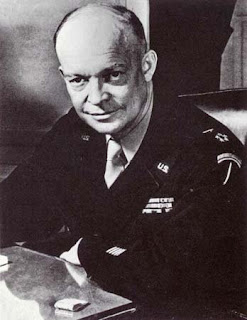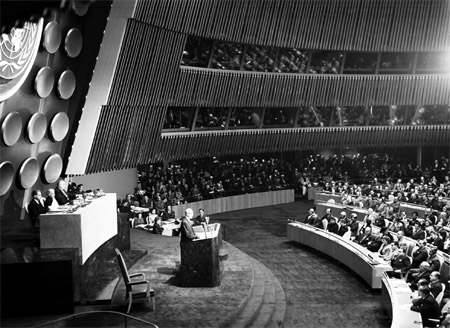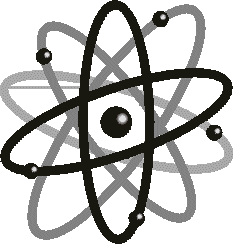Dwight D. Eisenhower
Document #851; April 27, 1954
Files, Coat of Arms Corr.
To Thorkild R. Knudsen
Series: EM, AWF, Microfilm Series: Personal
Part V: Maintaining "a united defense"; April 1954 to August 1954
Chapter 10: Losing the war "they could not win"
Dear Mr. Knudsen:1 I have two suggestions concerning the sketch of a proposed Coat-of-Arms to be sent to Denmark in connection with my membership in "The Order of the Elephant."2
The first one is that I would prefer to use as the motto the words "Peace Through Understanding" rather than the present "Peace Through Education." I realize that the quotation was originally taken from something I said several years ago, but I am inclined at present to feel that "Peace Through Understanding" more exactly approaches my philosophy today.
If it were possible to include on the design my SHAPE insignia I think I should like this done. I say this for the reason that the SHAPE organization was designed to promote peace, just as the SHAEF organization was developed to regain the peace.
I am sure the first change could be made, but if you find it would be awkward or impossible to make the second, I will withdraw the suggestion. As soon as I hear from you, I shall either return the sketch to you or forward it to the proper address in Denmark.3
With warm regard, Sincerely
1 Knudsen, a native of Denmark and chairman of the board of the Los Angeles-based Knudsen Creamery Company of California, had met with Eisenhower in Palm Springs, California, in February (on Eisenhower's Palm Springs vacation see no. 734).
2 In 1945 Eisenhower had been awarded Denmark's highest ranking order of knighthood, the Order of the Elephant. Believed to have been established in the twelfth century, the exclusive order was now reserved for foreign heads of state and members of royalty. In February, at Palm Springs, Knudsen had spoken to Eisenhower regarding the possibility of presenting the Eisenhower coat of arms and a portrait of the President to Copenhagen's Frederiksborg Castle Church Museum in connection with this honor. Following up on that conversation, Knudsen had written to the President's personal secretary Ann C. Whitman to report that the museum had requested the Eisenhower coat of arms, but not his portrait (Feb. 26, 1954 [not in EM]; Mar. 22, 1954, AWF/M: Pers., Coat of Arms Corr.). Knudsen then offered to have a presidential coat of arms made up because, as he recalled, Eisenhower said he did not have one. Whitman sent Knudsen an artist's sketch that the General had rejected in 1951 (Mar. 26, 1954, ibid.). Knudsen replied that plans were nevertheless underway for an artist in Los Angeles to design "an appropriate Coat-of-Arms for the President" (Mar. 30, 1954, ibid.).
Finally, on April 21 Knudsen sent Whitman the artist's rendering: "A careful study was made to see that the proposed Coat-of-Arms was heraldically correct for the President," Knudsen wrote, "and I feel certain that it is entirely appropriate" (ibid.). In addition to an anvil in its center--alluding to the Eisenhower name ("hewer of iron")--four fields designating Eisenhower's achievements appeared on the design: the presidential seal, the Columbia University seal, the SHAEF insignia, and five stars (see Knudsen to Whitman, Mar. 26, 1954, Whitman to Knudsen, Mar. 30, 1954, Knudsen to Whitman, Apr. 21, 1954, and copy of design, all in ibid.).
3 For developments see no. 856.
Bibliographic reference to this document:
Eisenhower, Dwight D. Files, Coat of Arms Corr.
To Thorkild R. Knudsen, 27 April 1954. In The Papers of Dwight David Eisenhower, ed. L. Galambos and D. van Ee, doc. 851. World Wide Web facsimile by The Dwight D. Eisenhower Memorial Commission of the print edition; Baltimore, MD: The Johns Hopkins University Press, 1996, http://www.eisenhowermemorial.org/presidential-papers/first-term/documents/851.cfm
Here it is:
The picture above is of Eisenhower’s arms as they appear in Frederiksborg Castle, photographed by Sunil Saigal, and posted on David B. Appleton's blog, Heraldry.
It does give one pause to think that the man who pushed the button had as his motto "peace through understanding". And now that the IAEA is so much in the news about Iran, we might notice that it was Eisenhower who proposed the creation of the agency in his "Atoms for Peace" speech at the UN, in 1953, the year in which I was born.

From the speech, "Atoms for Peace":
I feel impelled to speak today in a language that in a sense is new, one which I, who have spent so much of my life in the military profession, would have preferred never to use. That new language is the language of atomic warfare.
The atomic age has moved forward at such a pace that every citizen of the world should have some comprehension, at least in comparative terms, of the extent of this development, of the utmost significance to everyone of us. Clearly, if the peoples of the world are to conduct an intelligent search for peace, they must be armed with the significant facts of today’s existence.
My recital of atomic danger and power is necessarily stated in United States terms, for these are the only incontrovertible facts that I know. I need hardly point out to this Assembly, however, that this subject is global, not merely national in character.
On July 16, 1945, the United States set off the world’s first atomic explosion.
Since that date in 1945, the United States of America has conducted forty-two test explosions. Atomic bombs today are more than twenty-five times as powerful as the weapons with which the atomic age dawned, while hydrogen weapons are in the ranges of millions of tons of TNT equivalent.
Today, the United States stockpile of atomic weapons, which, of course, increases daily, exceeds by many times the total [explosive] equivalent of the total of all bombs and all shells that came from every plane and every gun in every theatre of war in all the years of World War II.
A single air group, whether afloat or land based, can now deliver to any reachable target a destructive cargo exceeding in power all the bombs that fell on Britain in all of World War II. In size and variety, the development of atomic weapons has been no less remarkable. The development has been such that atomic weapons have virtually achieved conventional status within our armed services.
In the United States, the Army, the Navy, the Air Force, and the Marine Corps are all capable of putting this weapon to military use. But the dread secret and the fearful engines of atomic might are not ours alone.
In the first place, the secret is possessed by our friends and allies, Great Britain and Canada, whose scientific genius made a tremendous contribution to our original discoveries and the designs of atomic bombs.
The secret is also known by the Soviet Union.
...the knowledge now possessed by several nations will eventually be shared by others, possibly all others....
The United States would seek more than the mere reduction or elimination of atomic materials for military purposes. It is not enough to take this weapon out of the hands of the soldiers. It must be put into the hands of those who will know how to strip its military casing and adapt it to the arts of peace.
The United States knows that if the fearful trend of atomic military build-up can be reversed, this greatest of destructive forces can be developed into a great boon, for the benefit of all mankind. The United States knows that peaceful power from atomic energy is no dream of the future. That capability, already proved, is here, now, today. Who can doubt, if the entire body of the world’s scientists and engineers had adequate amounts of fissionable material with which to test and develop their ideas, that this capability would rapidly be transformed into universal, efficient, and economic usage?
To hasten the day when fear of the atom will begin to disappear from the minds of people and the governments of the East and West, there are certain steps that can be taken now. I therefore make the following proposals:
The governments principally involved, to the extent permitted by elementary prudence, to begin now and continue to make joint contributions from their stockpiles of normal uranium and fissionable materials to an international atomic energy agency. We would expect that such an agency would be set up under the aegis of the United Nations.
The more important responsibility of this atomic energy agency would be to devise methods whereby this fissionable material would be allocated to serve the peaceful pursuits of mankind. Experts would be mobilized to apply atomic energy to the needs of agriculture, medicine, and other peaceful activities. A special purpose would be to provide abundant electrical energy in the power-starved areas of the world. Thus the contributing Powers would be dedicating some of their strength to serve the needs rather than the fears of mankind.The United States would be more than willing -- it would be proud to take up with others “principally involved” the development of plans whereby such peaceful use of atomic energy would be expedited.
Against the dark background of the atomic bomb, the United States does not wish merely to present strength, but also the desire and the hope for peace.





0 Comments:
Post a Comment
<< Home